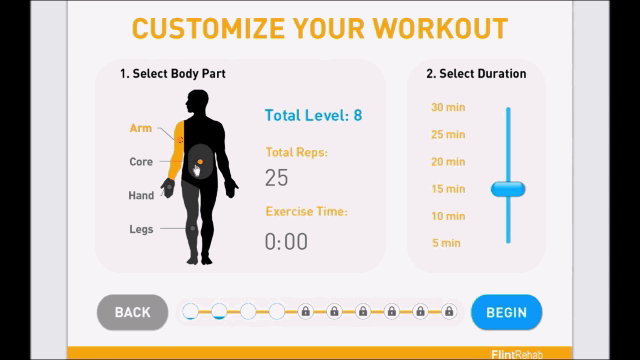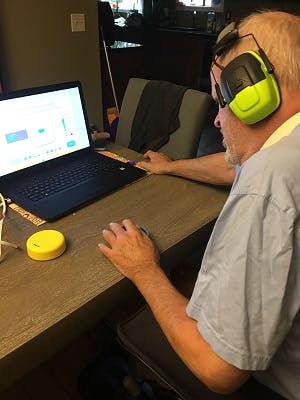Once survivors transition home or into outpatient therapy, it’s crucial to find a home exercise program for spinal cord injury. Consistent rehabilitation is key to maximizing recovery after spinal cord injury.
To help you stay active, we’ve put together a guide to help you create your best home exercise program after spinal cord injury. You’ll find plenty of example exercises, many wheelchair-friendly, that you can do with your therapist or caregiver from the comfort of your own home.
The Importance of a Home Exercise Program for Spinal Cord Injury
Practicing exercises daily helps activate neuroplasticity, the central nervous system’s ability to rewire itself. This helps improve mobility and restore function.
Neuroplasticity is best stimulated through high repetition, or massed practice. Therefore, having a home exercise program for spinal cord injury is essential to achieve the consistency and repetition necessary for recovery.
Every spinal cord injury is different, therefore every survivor will experience a different outcome. Every home exercise program for spinal cord injury should be tailored to your level of injury and include a mix of stretching, aerobic exercise, and strength training when possible.
Be sure to consult your therapist before trying any new exercises because it’s important to ensure the exercises are adjusted to your ability level.
While some of these rehab exercises can be challenging, try no to feel discouraged if you can’t perform them just yet. Remember that any movement is better than no movement, just keep doing your best.
Stretches for SCI Recovery At Home

A spinal cord injury can often cause muscles to tighten up, a condition known as spasticity. One of the best ways to prevent this from happening is to stretch and move your joints through their full range of motion. Well-stretched muscles and flexible joints help prevent strain and further injury.
To help jumpstart your SCI home exercise program, here are some examples of stretching exercises you can try. This includes:
- Posterior Shoulder Stretch: Put one arm out in front of you and keep it straight. Then move it across your chest. Bend your other arm at the elbow and use it to support the straight arm and gently pull it close to the chest. This will help stretch the back part of your shoulders.
- Overhead Shoulder Stretch: Raise both arms above your head and bend one of your elbows behind your head. Then place your other hand on your elbow and gently pull down. This will help stretch your triceps and deltoids.
- Lateral Stretch: Lean your torso to the side gently. You should feel a stretch on the opposite side. Make sure to hold onto something for support or have someone spot you for this stretch if you have difficulty.
- Hamstring Stretch: Use a chair or something similar to raise one leg off the ground and keep it straight. Then slowly lean forward towards your foot without hunching your back.
- Calf Stretch: If you’re able to stand, place both arms on a wall and move one of your legs a step back. Try to get the heel of that foot as close to the ground as possible. You should feel the stretch in the back of your calf. If you’re in a wheelchair, you can try putting your toes up against the wall (while keeping your heel on the ground), and leaning toward that leg.
Stretching should be gentle, and if you experience numbness in the affected area, it’s extra important to focus on gentle movements. Do not force anything against your body’s natural resistance.
Mobility Training Exercises for At-Home Rehabilitation

Along with stretching your affected muscles, it’s important to practice high repetition of therapeutic exercises to help stimulate the nervous system and encourage better mobility.
To achieve this, you can work with your therapist to pick specific exercises for spinal cord injury that target your affected muscles, like the upper and lower extremities.
Here are some examples of exercises your therapist may recommend adding to your home therapy regimen after SCI:
- Seated Marching: Sit at the edge of a chair with both of your feet on the ground. Lift one knee slowly and place it back down in the same position and alternate.
- Wrist Extension: With your palm facing down, hold one arm out in front of you. With your other hand, grab the palm and slowly pull it back up.
- Arm Circles: Spread your arms out to your sides and align them with your shoulders. Then slowly make circular motions (either large circles or small circles) forward and backward.
- Trunk Rotation: Lay on your back with your knees bent and feet flat on the floor. Then try to tighten your abdominal muscles and move your trunk in circular motions.
While these exercises may seem simple, they are extremely effective when practiced consistently because they help activate neuroplasticity and improve mobility over time.
Strength Training Exercises for SCI Recovery
Rebuilding strength can also help improve mobility after spinal cord injury. Therefore, strength training can be included in your home exercise program for SCI once your therapist clears you.
Here are a few strengthening exercises for spinal cord injury that you can incorporate into your home regimen:
- Shoulder Press: Spread out both of your arms to the side so that you’re making a “T” formation. Then bend your elbows to a 90-degree angle so that your palms are facing forward. Move your hands up to the ceiling, straighten your elbows, and bring them back down to 90-degrees.
- Arm Curls: Keep your arms straight at your sides and then bend your elbow. Bring your forearm up so that your hand approaches the shoulder, then lower it back down to your starting position.
- Heel Raises: Heel raises mimic the movements made when taking steps. For this exercise, sit at the edge of your seat with your feet planted on the floor. Then slowly lift your heel. You should feel both your calves and ankles extend.
If you would like to increase difficulty and resistance, you can use a free weight dumbbell or cuffed weight. Again, be sure to exercise caution and avoid overstraining yourself, especially if you experience numbness or impaired sensation in your affected limbs.
Motivation for Your Home Therapy Program After Spinal Cord Injury

Exercising at home can be challenging especially when you’ve been used to working with a therapist. However, it is essential to remain engaged in between therapy sessions to keep neuroplasticity stimulated. Thus, investing in gamified, neurorehabilitation devices can help.
For example, FitMi is an interactive home exercise program that motivates you to perform high repetition of full-body rehab exercises after SCI. It keeps you motivated by tracking your progress and adapting to your ability level.
FitMi is ideal for staying engaged in therapy between visits with your therapist because it can be used from the comfort of your own home, on your own time, for as long as you want.
Here’s an inspiring story from a spinal cord injury survivor that uses FitMi in their home therapy program:

“My husband had a spinal infarction in November. Believe me when I say it was touch and go for months. After extensive medical care and in hospital rehabilitation he was able to come home 8 weeks ago. He is paralyzed on left side and has all the spinal ailments that come with spinal cord accidents and also all the ailments that come with stroke patients. This program AND the MusicGlove are life savers. Not only is he regaining movement but it gives him purpose. He gets up at 7 am every morning and works with the pucks and the gloves until noon. We are seeing improvement. It’s slow but it IS improvement. ”
-Rockey
FitMi is the ultimate home exercise program for spinal cord injury survivors looking to improve mobility.
Adapting a Home Exercise Program for Spinal Cord Injury
Rehabilitation is an important part of spinal cord injury recovery. Therefore, it’s essential for survivors to find the most suitable home exercise program for spinal cord injury. This can include stretching and specific rehab exercises that target your affected limbs. For motivation you can use interactive, gamified neurorehabilitation devices like FitMi.
We hope this article has motivated you to adapt a home exercise program for spinal cord injury to help you stay engaged and promote recovery.
The post Home Exercise Program for Spinal Cord Injury: How to Create Your Best Regimen appeared first on Flint Rehab.



